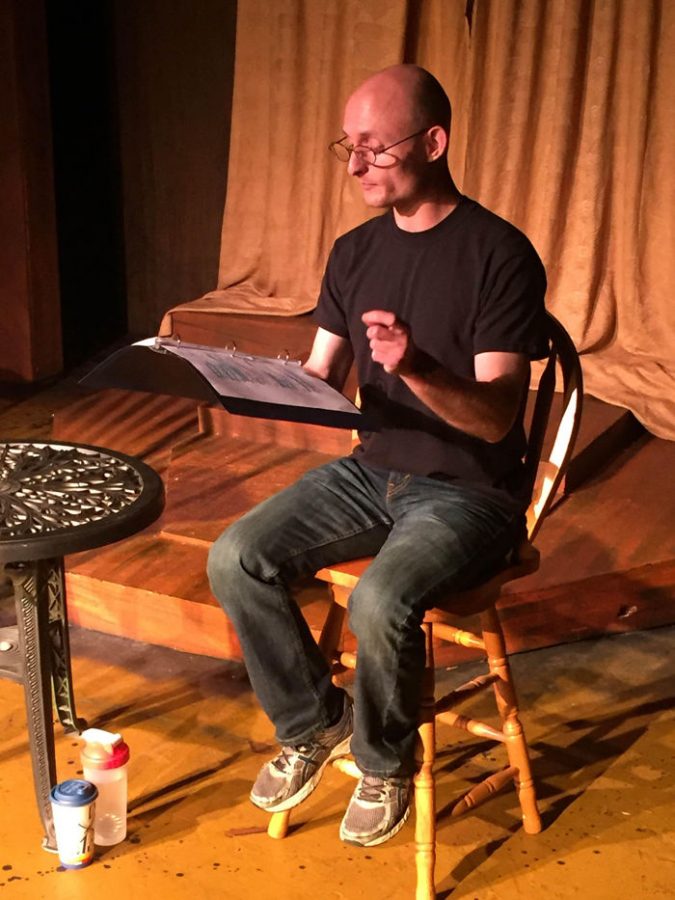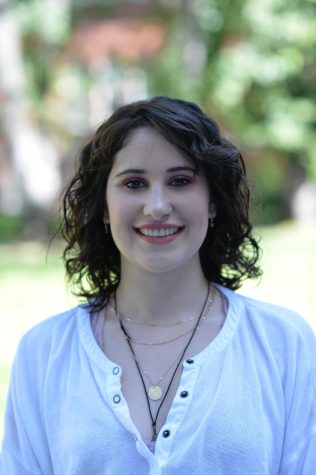Pullman Civic Theatre hosts virtual plays
Virtual plays bring original scripts, talent to YouTube during quarantine
Actor Matt Maw reads from a script during a 2016 readers theater production titled, “The Woman in Black.”
June 19, 2020
If you ask, Mike Long may tell you about the time he killed someone with an umbrella.
Well, not really.
As a sound effect designer, producer, writer and director for the Pullman Civic Theatre, Long is used to finding unusual ways of setting the sounds of a story.
If the script calls for the whooshing sound of a knife passing through the air, Long grabs his umbrella and opens it. If characters are struggling their way through a storm, he has his homemade “thunderboard,” which is common in films and plays that record live weather sounds.
Recently, the shutdown of in-person plays changed how he’s done this job, Long said. He still keeps a stump and even fruit on stage with him — for sound reasons — but works without his usual group of PCT colleagues.
“The biggest change is that I’m at the theater by myself,” Long said. “No cast members or crew. Just me alone in the very dark theater.”
Since the shutdown of in-person theaters, the Pullman Civic Theatre has uploaded largely original content on its YouTube channel, with genres that range from horror-thrillers to fantasy-adventures in the style of popular role-playing game Dungeons & Dragons.
“Adventurers” is a fantasy story following the journey of two sisters, PCT Art Director Kristin Lincoln said. PCT member Sam Opdahl wrote the short play, and the cast worked to perform, record and upload it to the channel in a short time, Lincoln said.
“I’m blown away by how much we’ve had to think outside the box,” Lincoln said.
Holly O’Connor, the president of the PCT board of directors, said “Adventurers” became a three-part story-line after Long offered to write the second episode.
“It strikes that fantasy side and lightheartedness that we really need,” O’Connor said.
Lincoln said the virtual plays also fulfills a health need for consuming art, she said.
“We knew pretty much right away if people were going to be stuck in their homes, there was going to be a mental health problem,” Lincoln said.
O’Connor said she is glad that everyone involved has made such an effort to make these short plays enjoyable.
As most of the plays are written and performed by cast members, Lincoln said this project offers chances for members to create.
Long said his favorite part of sound effect design is being creative.
“When I’m reading a script, I’m thinking, ‘OK, how am I going to make the sound of fire? How am I going to make the sound of laser guns?’” he said. “It needs to be enough that you can see in your mind, like, what’s happening.”
Long said he keeps a doorknob, a handmade wind turbine and a typewriter on stage with him. For the first episode of the online series, “The Procedure,” he uses a long pencil and a wooden board to illustrate the sounds of writing.
Without visual storytelling techniques such as stage blocking as well as costume and prop design, Long said sound is integral to the online plays.
“The sounds are more important than they used to be,” Long said.
As theaters consider when to reopen, Long said he knows many people are just looking for a break.
Many people will still have reservations about returning to live shows, even with proper social distancing measures, O’Connor said.
“Audience confidence is a big factor,” she said.
O’Connor said PCT is unsure when it will have live shows, but she said they want to continue the virtual theater in some format. She said she hopes people continue to support the arts, as many local artists are facing financial struggles.
“I’m lucky I get to go to work every day,” Long said. “But I know some folks who don’t get to go to work, or work from home, or have been laid off, so we’re trying to give them something to break up the quiet monotony.”























